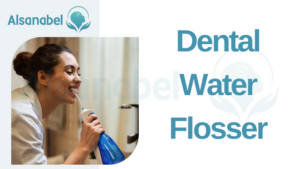Understanding the importance of oral hygiene
When it comes to oral hygiene, flossing is an essential part of maintaining healthy teeth and gums. Traditional flossing with dental floss is a popular method, but there is an alternative option available: dental water flosser.
Maintaining good oral hygiene is crucial for overall health. Regular brushing and flossing help prevent plaque buildup, tooth decay, and gum disease. By flossing, you remove food particles and bacteria from hard-to-reach areas between your teeth and along the gumline.
Exploring different methods of flossing
- Traditional Flossing:This method involves using a thin nylon thread or string to manually clean between your teeth. Traditional flossing requires proper technique and dexterity to effectively remove plaque and debris.
- Dental Water Flossers:Also known as oral irrigators, dental water flossers use a stream of pressurized water to clean between teeth and along the gumline. This method is gentle on gums and can be a great option for people with braces or dental implants.
Comparing traditional flossing to dental water flossers
- Ease of use:Dental water flossers are generally easier to maneuver, especially for those with limited hand dexterity or braces.
- Efficiency:Water flossers can be more effective in removing plaque and reducing gum inflammation when used properly.
- Comfort:Some people may find water flossers more comfortable and less irritating to their gums compared to traditional floss.
In summary, both traditional flossing and dental water flossers are effective methods of maintaining oral hygiene. The choice depends on personal preference, oral health needs, and any specific dental conditions. Consulting with a dentist can help determine the best option for individual oral care.
Traditional Flossing

Traditional flossing technique
When it comes to maintaining good oral hygiene, one of the most commonly recommended practices is flossing. Traditional flossing involves using a thin, waxed nylon string to clean between the teeth and along the gumline. The technique requires wrapping the floss around the fingers, gently sliding it between teeth, and making a C-shape motion to remove plaque and food particles.
Benefits and drawbacks of traditional flossing
Traditional flossing has been a staple in oral care for decades, and for good reason. Here are some of the benefits:
1.Effectiveness:When done correctly, traditional flossing can effectively remove plaque and debris from hard-to-reach areas, reducing the risk of gum disease and cavities.
2.Portability:Traditional floss is compact and easy to carry, making it convenient for on-the-go use.
Overall, traditional flossing remains an effective method for maintaining oral health. However, advancements in dental technology have introduced alternative options like dental water flossers, which offer additional benefits and ease of use.
Dental Water Flosser
A dental water flosser, also known as an oral irrigator, is a device used for oral hygiene. It is a popular alternative to traditional flossing methods. This handheld device uses a stream of pulsating water to remove plaque, bacteria, and debris from between the teeth and along the gumline. It is a gentle yet effective way to clean and improve oral health.

How does a dental water flosser work?
A dental water flosser works by directing a pressurized stream of water into the mouth. The water stream, when aimed properly, can reach areas that are difficult to clean with traditional flossing methods. This includes the spaces between teeth and the gumline. By effectively flushing out food particles and bacteria, it helps prevent gum disease, cavities, and bad breath.
The water pressure of a dental water flosser can be adjusted to suit individual preferences and needs. Some models also come with different attachments, such as specialized tips for braces or implants. The device is easy to use and can be a convenient addition to your oral care routine.
Compared to traditional flossing, a dental water flosser may offer several advantages. It is gentler on the gums and is less likely to cause bleeding or discomfort. It is also more efficient at removing plaque and can reach deeper into the spaces between teeth. However, it is important to note that while a dental water flosser can be a valuable tool in oral care, it should not replace brushing and regular dental check-ups.
Read More:
Comparison between Traditional Flossing and Dental Water Flosser
Effectiveness in removing plaque and debris
When it comes to oral hygiene, keeping plaque and debris at bay is crucial. Traditional flossing involves using a string or tape to manually remove food particles and plaque from between teeth. While it is effective, it can be challenging for some people to reach all areas of the mouth, especially for those with braces or dental work.
On the other hand, a dental water flosser uses a stream of pulsating water to clean between teeth and along the gumline. The water pressure helps dislodge plaque and debris, providing a thorough cleaning. It is particularly beneficial for those with braces, implants, or bridges as it can access hard-to-reach areas more easily.
Ease of use and convenience
Traditional flossing requires manual dexterity and coordination, which can be difficult for some individuals. It can also be time-consuming, especially for those with limited mobility or crowded teeth. Dental water flossers, however, are incredibly easy to use. With a press of a button, the water stream does the work, making it a convenient option for people of all ages. Additionally, water flossers can be more gentle on the gums, reducing the risk of cuts or discomfort compared to traditional floss. They also come with various attachments, allowing for customization based on individual needs, including specialized tips for orthodontic appliances or sensitive gums.
In summary, both traditional flossing and dental water flossers are effective in removing plaque and debris, but a dental water flosser offers added convenience and ease of use, especially for those with braces or dental work. Ultimately, the choice between the two methods depends on personal preference and individual oral health needs.
Advantages of Dental Water Flosser
For many years, traditional flossing has been the go-to method for maintaining oral hygiene. However, there is a newer and more effective option available – the dental water flosser. This innovative device offers a number of advantages over traditional flossing.

Gentle and soothing for sensitive gums
One major advantage of using a dental water flosser is its gentle and soothing nature, which is particularly beneficial for individuals with sensitive gums. The pulsating water stream massages the gums, promoting better circulation and reducing the risk of irritation or bleeding. This makes it an ideal alternative for those who find traditional flossing uncomfortable or painful.
Reaching difficult-to-access areas
Another advantage of the dental water flosser is its ability to reach difficult-to-access areas in the mouth. Traditional flossing can be challenging when trying to clean between tightly spaced teeth or around dental work such as braces, bridges, or implants. The powerful water stream produced by a water flosser can easily access these areas, removing plaque and debris effectively.
In summary, the dental water flosser offers several advantages over traditional flossing. Its gentle and soothing nature makes it suitable for individuals with sensitive gums, while its ability to reach difficult-to-access areas ensures comprehensive oral hygiene. Consider incorporating a dental water flosser into your daily oral care routine to enhance your dental health.
Choosing the right flossing method for your oral care routine
When deciding between a dental water flosser and traditional flossing, it’s important to consider the following factors:
- Ease of use:Dental water flossers are generally considered easier to use, especially for individuals with limited dexterity or those wearing braces or other orthodontic devices.
- Effectiveness:Traditional flossing allows for more direct contact with the teeth and gums, making it effective in removing plaque and debris. However, dental water flossers can also reach areas that are difficult to access with traditional floss.
- Comfort:Some people find dental water flossers more gentle and less likely to cause gum irritation compared to traditional flossing.
- Cost and maintenance:Dental water flossers may require an initial investment, but they can be cost-effective in the long run, as they eliminate the need for buying floss regularly. However, they do require regular maintenance and replacement of the water reservoir and tips.
Ultimately, the most effective oral care routine includes regular brushing, flossing, and visits to the dentist. Consulting with a dental professional can help determine the best flossing method for your specific needs and ensure optimal oral health.
Remember, regardless of the flossing method you choose, consistency is key. Committing to a regular flossing routine will greatly contribute to improved oral hygiene and overall well-being.
